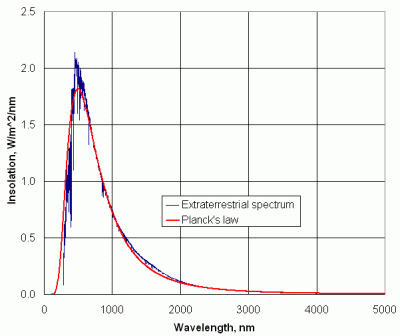What Color is the Sun??
By Lou Mayo
Seems like a silly question; “What color is the sun?”. Everyone knows the sun is yellow, right? It’s right there in the sky; you just have to look to know this (OK, don’t really look at the sun…). Well…not so fast. It turns out that there are many absolutely correct and absolutely different answers to this seemingly simple question.
Our perception of color is influenced by, of course, the wavelength of the emitted light, the intensity of the emitted light (I’ll explain this later), environmental factors, the ability and limitations of our eyes to collect light, and finally, our brains. So, let’s begin with the wavelength of light.
As with all matter, the sun emits a “black body spectrum” that is defined by its surface temperature. A black body spectrum is the continuum of radiation at many different wavelengths that is emitted by any body with a temperature above absolute zero. For our sun, this black body curve or “Plank Function” is a smooth almost bell shaped curve involving electromagnetic (EM) radiation at many different wavelengths from very long infrared to very short ultraviolet wavelengths. During very hot, explosive, high energy solar flare events, the sun emits huge amounts of x-ray and gamma ray radiation as well, up to over 100 MeV energies and up to 1032 ergs of energy over only a few seconds or tens of seconds! These massive solar flares are huge explosions in the sun’s atmosphere caused by the sudden release of magnetic field energy and tend to occur near solar maximum. The flares also accelerate charged particle plasmas to high speeds resulting in radio emission. So, the sun actually emits energy at all wavelengths from radio to gamma ray. But, as can be seen in the image above, it emits most of its energy around 500 nm, which is close to blue-green light. So one might say that the sun is blue-green! This maximum radiation frequency is governed by the sun’s surface temperature, around 5,800K. A higher surface temperature would result in a shorter maximum wavelength and our sun might peak in the blue or violet part of the spectrum (or even the ultra violet!). A lower surface temperature, and our sun’s spectrum might peak in the yellow or orange or even red part of the spectrum. But this is physics, not perception. I must note here another spectral signature from the sun, the photon flux. If we use the relationship found by Max Planck, E = hf (that is Energy = the Planck Constant times the Frequency) and convert the solar irradiance into photon counts, the spectral signature across visible wavelengths is much flatter and the sun is perceived as more yellow.
If we were above the atmosphere, say on the International Space Station and looked at the sun (through our filtered visor), the sun would appear white! Why? Because though the sun emits strongest in the green part of the spectrum, it also emits strongly in all the visible colors – red through blue (400nm to 600nm). Our eyes which have three color cone cell receptors, report to the brain that each color receptor is completely saturated with significant colors being received at all visible wavelengths. Our brains then integrate these signals into a perceived white color.
Here on Earth, the atmosphere plays a role in the color of the sun. Since shorter wavelength blue light is scattered more efficiently than longer wavelength red light, we lose some of the blue tint of the sun as sunlight passes through the atmosphere. In addition, all wavelengths of visible light passing through our atmosphere are attenuated so that the light that reaches our eyes does not immediately saturate the cone receptors. This allows the brain to perceive color from the image with a little less blue – yellow. Though it does not affect what our eyes see, all x-ray and gamma ray radiation is filtered out before it comes close to the ground. Most UV is absorbed by stratospheric ozone (above 10km) and most IR is absorbed by water vapor and other molecules with non - zero dipole moments.
Of course, when sunlight passes through a lot of atmosphere as is the case with sunrises and sunsets, even more blue light is scattered and a much greater percentage of the longest wavelength (red) light makes it to our eyes.
So, you see, there is no simple answer to this question, but the good news is that you can defend almost any answer!






